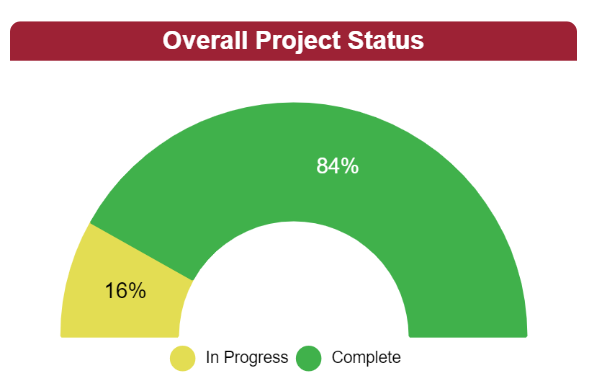Project Planning and Updates

The classification and compensation project approach comprises four main phases. Each phase of the work builds on the other, while key concepts are presented repeatedly and revisited for alignment.
- Define the Work: What job profiles encompass the work occurring across campus and who is doing this work?
- Link to Market: What similar work is occurring within the selected market and how is this work compensated?
- Update Processes: How can we update administrative pay and classification processes to prepare for a future state?
- Plan for Improvement Changes: What is the best course of action to achieve more market alignment, including title and pay, based on the findings of this study?
Status Updates
The project is on track for on-time completion following the 18-month scope of work as announced in October of 2022.
March 2024
In March, the project team accomplished the following milestones:
- Project leadership discussed a detailed implementation timeline, identified key dates and milestones, reviewed market adjustment scenarios, and provided feedback on proposed guideline changes.
- Leadership and budget staff met to align implementation steps with budget development.
- Discussed guidance on preferred state titling by job profile, FLSA status changes.
January-February 2024
In January-Feburary, the project team accomplished the following milestones:
- Met with university leadership to discuss possible implementation strategy for market-aligned base pay, developing roadmap and list of decisions
- Progressed playbook of pay and classification practices and guidelines, summarizing key changes and guidelines
- Met with more than 20 stakeholders to understand and map current business processes, identifying challenges and opportunities for consistent and streamlined processes to implement
- Reviewed employee mapping to job profiles with Deans
- Validated targeted employee mapping reviews with HR Partners, making recommended changes
Fall 2023
In September-December, the project team accomplished the following milestones:
- Completed HR Partner and unit-level reviews of employee mapping
- Reset governance groups to include:
- Compensation and Policy Work Team to iterate on market analysis and design future administrative practices
- Training Team to focus on change management strategies for various stakeholders
- Systems Team to begin discussing Workday requirements
- Engaged Deans and Strategic Operations Group to calibrate employee mapping to job profiles, facilitated feedback and reviews through HR Partners
- Met with executive leaders to consider compensation strategy scenarios
- Project team began training on fundamentals, classifications and benchmarking practices
- Refreshed employee data for analysis and began mapping new employees and provisionals
- Analyzed employee mapping for institutional calibration exercises
- Began building "playbook" of pay and classification practices and guidelines
- Prepared for Workday testing of Job Classification Architecture
- Began business process documentation for 8-10 business processes

Summer 2023
In summer 2023, the project team accomplished the following milestones:
- Trained HR Partners on the job classification architecture and empowered them to support the employee mapping portion of the project
- Began discussing future compensation and classification practices and documenting a “playbook” to serve as a future guide
- Started preparing preliminary mapping of 2,300 in-scope employees to the drafted job profiles
- Worked on initial stages of compensation analysis preparation process
- Worked with HR Partners and unit leaders to review and provide feedback to job profile mapping
- Conducted compensation analysis, market pricing of job profiles to salary surveys, and preliminary financial impact analysis
So far this Summer, the team has engaged with 19 HR Partners and 62 unit leaders to initiate review of employee mappings to job profiles (meetings went through project scope, objectives, resources and questions). Huron also proposed benchmark job profile matches from Mercer, the College & University Professional Association (CUPA), and the Northwest Arkansas Human Resources Association (NOARK) for the compensation team to verify.
Spring 2023
Employer of Choice Town Hall Discussion
As part of the university’s 150 Forward strategic planning process and campuswide town hall series, U of A leaders recently discussed the classification and compensation project in support of the employer of choice strategic priority. At the meeting, chief people officer Michelle Hargis Wolfe said pay and career paths often arise as determinants of whether or not someone chooses to come to and stay at the university.
“Getting our compensation and classification right is critical to being an employer of choice,” Hargis Wolfe said. “We’re using data to create a consistent structure that ensures we are market competitive across the board.”
Subject matter experts were selected from every unit to work together to define work performed by staff roles across campus and group them into job families, as well as corresponding subfamilies. The classification and compensation project team intends to provide monthly training and updates about what terms like job architecture, job profiles and compensation philosophy mean, and the U of A's approach to establishing them.
Even though the classification and compensation project is specific to staff roles, provost Terry Martin shared that evaluating salaries for faculty roles at the departmental level is coming “on the heels” of the staff project.
While panelists stated the importance of compensation being consistent across campus and competitive by sector and region, chancellor Charles Robinson mentioned the U of A also has an obligation to keep education as affordable and accessible for students as possible. Robinson and other leaders also said that pay should be considered alongside factors the university is uniquely positioned to offer – such as a clear mission, accomplishing impactful work in a family-like environment, stability and other benefits.
